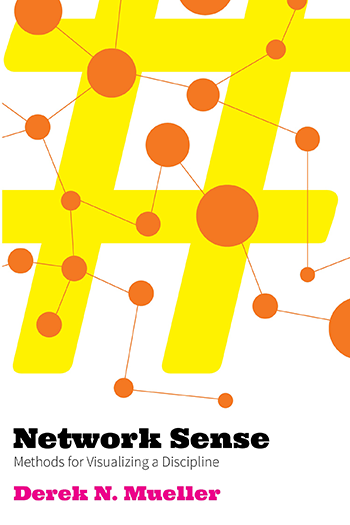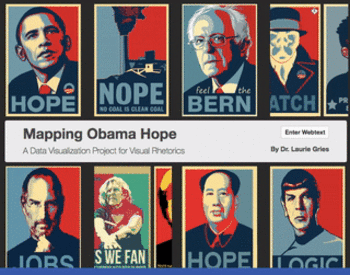Methodological Play
Thin Description and Data Visualization
In developing our methodology for this project, we’ve been deeply influenced by the work of Derek Mueller, which demonstrates the value of “distant and thin” methods of data visualization as a means of re-seeing the disciplinary evolution of rhetoric and writing studies (Mueller 2012a; Mueller 2012b; Mueller 2018). Synthesizing Heather Love’s articulation of “thin description” with Franco Moretti’s framework of “distant reading,” Mueller’s Network Sense theorized and demonstrated a range of “abstracting practices that culminate in scalable visual models, a suite of patterned images useful for stirring questions about disciplinary trends and relationships” (7). By quantifying and visualizing selected features of a large corpus of texts (e.g., twenty-five years of articles in the journal College Composition and Communication), Mueller demonstrated how “distant and thin” methods of textual analysis can help us uncover trends in the disciplinary evolution of rhetoric and writing studies that might otherwise be imperceptible. By visualizing citation and word frequencies in CCC over a wide swath of time, Mueller was able to reveal the increasing fragmentation and specialization of the field as well as challenge some common ways of discussing “turns” in scholarship.
Mueller’s graphing of the most frequently occurring words and citations in CCC functioned as a kind of “abstracting” practice that allowed him to focus on a specific aspect of the textual corpus while letting other parts fall away. This kind of abstraction and reduction can be useful because very often, disciplinary “patterns are obfuscated amidst complexity until they are presented with varying degrees of selectivity and abridgement” (Mueller 2018, 62). Of course, these acts of selective abridgement also entail the making of ideologically-loaded choices that in turn obscure the complexities of the individual texts under consideration, but it’s important to remember that all historical research involves practices of selection and reduction. For example, when scholars choose to closely analyze a specific text and intensively unpack the implications of particular quotes within it, they are also necessarily choosing to ignore many other texts that could be considered. Historiography, we must remember, is always an interested curation of artifacts and their analyses, a lesson that Mueller’s work helps highlight, often in strikingly visual ways.

While close reading is a great method for teasing out the implications of a small number of texts, it can be too time consuming for engaging with larger textual corpora. Accordingly, Mueller argued that quantitatively coding and visualizing slices of textual data can be a way for us to begin to account for the field’s growing “reading problem in which relevant materials are produced at a pace far exceeding anyone’s ability to keep up with them by conventional reading strategies alone” (Mueller 2018, 25). Mueller dated the origins of this reading problem to the proliferation of rhetoric and writing scholarship around 1987 (Mueller 2018, 14), but we contend that historians of the field also increasingly face a “reading problem” as our knowledge of diverse archives of writing instruction has continued to grow in light of ongoing historical research as well as large-scale digitization projects—in our case, the century-plus back catalog of English Journal on JSTOR. Whether we are trying to keep up with the field in the present or attempting to tell more robust stories about our past, there is simply too much material available for scholars to be able to analyze solely through intensive close reading practices.
Making the case for employing digital tools to conduct “macroanalysis” of expansive textual archives, Matthew Jockers compellingly argued that:
Today’s literary-historical scholar can no longer risk being just a close reader: the sheer quantity of available data makes the traditional practice of close reading untenable as an exhaustive or definitive method of evidence gathering. The same argument, however, may be leveled against the macroscale; from thirty thousand feet, something important will inevitably be missed. The two scales of analysis, therefore, need to coexist. (Jockers 2013, 9)
Although our own relatively small archive does not require us to employ the kind of intensive computational linguistic methods that Jockers advocated, we nevertheless sympathize with his assertion that historical scholars must move beyond close reading alone so that we can offer more copious evidence for the arguments we make about the past. We also wholeheartedly agree with Jockers’ contention that macro and micro scales of analysis must necessarily work in concert with one another. While both Jockers and Mueller argued that “macroanalysis” methods must ultimately be combined with close reading, their books each presented a series of case studies showcasing distant, macroanalysis methods without taking the step of demonstrating exactly how these methods might be combined with intensive close reading of texts from the same archive (an understandable limitation, given the broad scope of their projects). Seeking to address this gap, we work in this book to demonstrate the potential benefits that can be gained by viewing an archive at various levels of scale, both “macro” and “micro.”
In addition to considering the limitations and benefits of close reading as a method, we also seek to question (alongside Love and Mueller) our field’s privileging of Geertzian practices of “thick description” (Geertz 1973) that emphasize the detailed unpacking of the polyvalent meanings and contextual influences operating in a small number of texts or other communicative interactions. Challenging the supremacy of “thick description” in the field, Mueller drew on the work of Heather Love to suggest that we might also consider the value of forms of “thin description” (Love 2013) that focus more on observing surface features of a wide range of texts rather than on interpreting the many layers, contradictions, and hidden forces animating a single text: what we may lose in depth and nuance of interpretation with this approach, we can gain in breadth and copiousness of evidence. In contrast to Moretti and Jockers’s privileging of machine reading of massive archives at very distant levels of scale, Love’s articulation of “thin description” pointedly does not seek to remove the human reader from the act of reading, but rather to offer a different orientation to reading that focuses our attention more on systematic observation of textual features rather than on nuanced hermeneutic interpretation. We find that Love’s feminist articulation of “thin description” as a human observational practice is more in line with our commitment to embodied knowledge making practices that highlight how technologies and research methods reflect the social positionalities of the humans who employ them (Almjeld and Blair 2012; Enoch and Bessette 2013; Hidalgo 2017; Royster and Kirsch 2012). At the same time, we also recognize that our choice to retain an emphasis on the value of the human practice of “thin description” ultimately necessitated that we limit the scope of the archive we engage in this project.
As we draw inspiration from Heather Love’s articulation of the value of “thin description,” we’ve also been influenced by a burgeoning literature in rhetoric and writing studies that has employed systematic coding and data visualization methodologies in order to investigate trends in the development of the discipline. In recent years, composition and rhetoric scholars have productively employed data-driven methodologies in order to re-see numerous disciplinary archives, including post-World War II academic journals (Goggin 2000), rhetoric and composition dissertations (Miller 2014; Miller 2015), CCC and Rhetoric Society Quarterly article citations (Detweiler 2015), online journals (Tirrell 2012), Modern Language Association (MLA) job advertisements (Lauer 2013; Lauer 2014), and disciplinary social networks (Miller, Licastro, and Belli 2016). While all of these examples of disciplinary data mining have usefully helped rhetoric and writing scholars begin to confront the previously mentioned “reading problem” (Mueller 2018) we all increasingly face, most of this work has been decidedly contemporary in orientation—with the notable exception of Goggin’s study. By employing data visualization as a strategy for re-seeing a hundred-year-long pedagogical archive, we seek to demonstrate how emerging data-driven methods for visualizing the disciplinarity of rhetoric and writing studies can potentially help us reimagine our field’s long past as well as its unfolding present.

By demonstrating how systematic coding and data visualization can help us re-see disciplinary histories, we are pointedly not seeking to make positivist claims of empirical truth. We concur wholeheartedly with Johanna Drucker’s contention that “most information visualizations are acts of interpretation masquerading as presentation. In other words, they are images that act as if they are just showing us what is, but in actuality, they are arguments made in graphical form” (Drucker 2014, 10). In both our choices of what data to include as well as our choices about how to present it graphically, we recognize that we are most certainly foregrounding some aspects of the reality of the English Journal archive while masking others. In the end, we see our graphs not as images of truth, but rather as inventive heuristics that can enable us to consider new ways of asking generative questions about archives. We echo Mueller in asserting that our data visualizations should not be seen as “proofs, finally, but provocations; not closures, but openings; not conclusions or satisfying reductions, but clearings for rethinking disciplinary formations—they stand as invitations to invention, to wonder” (Mueller 2018, 4). Accordingly, we’ve specifically designed our visualizations in this book to be interactive so that readers can play with them, manipulate them, and start to ask their own questions about our corpus.
In our attempt to value multiplicity and interaction in data visualization, we’ve been guided by Johanna Drucker’s contention that designing “multiple imaging modes that create palimpsestic or parallax views of object make[s] it more difficult to imagine reading as an act of recovering truth, and render the interpretive act more visible” (Drucker 2014, 191). As one example of how we provide a palimpsestic view of the archive, chapter 3 includes interactive line graphs in which users can look at all articles about a medium as represented on a multiyear line, or they can zoom in one point on the graph, click a link and view one of the particular articles in the JSTOR archive itself. In this way, we hope that readers may be inspired to read some of the articles in our archive and in so doing come to challenge some of the stories that our graphs tell about those articles. Yet, as much as we hope that our visualizations can inspire readers to ask questions and proffer interpretations that we could not even have imagined, we recognize (along with Drucker and Mueller) that even interactive, multiplicitous visualizations are “rhetorical in that the visual models they produce articulate potentially patterned images that function as arguments, influencing ways of thinking” (Mueller 2018, 69). After all, we remain mindful that each of our graphs ultimately represent only small selections of the possible patterns that could be found in our corpus; furthermore, we have necessarily limited the ways in which users can manipulate the data, constraining what kinds of questions they can potentially ask.
Considering data visualizations as inventive heuristics rather that settled depictions of truth, we look to Laurie Gries’s powerful data visualizations documenting the circulation of the Obama hope image. As a rhetorical scholar, Gries found that the process of composing data visualizations enabled her to greatly enlarge her data set, as well as to locate new concatenations of texts that might benefit from more close, qualitative analysis. For Gries (and for us as well), “digital visualization techniques are useful, then, for deepening our data sets and complicating the rhetorical stories that we aim to tell. In pointing to new places for qualitative research, of course, they can also help generate new insights and arguments” (Gries 2017). In this way, we can see that systematic coding and data visualization need not be a replacement for more traditional forms of qualitative analysis. Rather, the turn to composing data visualizations can be an inventive process for reseeing our archives, asking new questions and looking in new locations.

Although we do not seek to position thin description and data visualization as more “objective” than other ways of analyzing texts, we have found that our work systematically coding specific features in our corpus has changed our own scholarly reading practices in productive ways. When we each wrote our previous historical books, we developed a core argument quite early on and then consciously searched for textual evidence to support that argument; furthermore, because we were committed to “thick description” as a historical methodology for our earlier books, we searched our archives looking for novel and complex texts that would require extensive analysis—quickly pushing aside many of the mundane or routine texts in our archives that would not reward such deep levels of interpretation. In contrast, when we set out to code all articles relevant to new media in English Journal for this project, we didn’t have any clear argument in mind, and we didn’t even begin to formulate some provisional claims until after we had read and begun to visualize fifty years of the corpus. We simply read and recorded what we noticed in a systematic way; we occasionally made quick notes about texts we found particularly exciting, but for the most part we spent about as much time engaging the “boring” or mundane articles in the archive as we did the novel and innovative ones.
Instead of seeing ourselves as gathering textual quotes to support a persuasive narrative argument, we saw ourselves first and foremost as building a database (in our case, a Google spreadsheet) that we could then query in order to explore a range of possible stories we might tell. Our decision to begin research with a process of database creation was a conscious choice to resist the rush to narrative closure that had characterized our past historical work. As Mueller argues (drawing on the work of Hayles and Manovich), the “database generally follows a paratactic logic (shuffling in any direction), whereas narrative, generally follows a syntactic logic (linearly sequenced, progressive)” (Mueller 2018, 51). In this way, we can see how reading initially for the purpose of database creation can be a way to temporarily disrupt our tendency to push too quickly towards narrative closure. That said, while the turn to database creation did help us disrupt our desire to impose a univocal linear narrative on our archive, we recognize, too, that our selection of a particular archive and coding scheme has also limited the stories that we can possibly tell. Ultimately, we take as axiomatic that all methodologies of textual analysis involve ideologically loaded processes of selection and reduction. Our goal here then is not to arrive at the incontrovertible truth of the history of new media in English pedagogy, but rather to explore how born-digital, multimodal methodologies of historical scholarship might enable us to offer more complex, at times even contradictory, visions of an archive presented at varying levels of scale and viewed through different analytical lenses.
